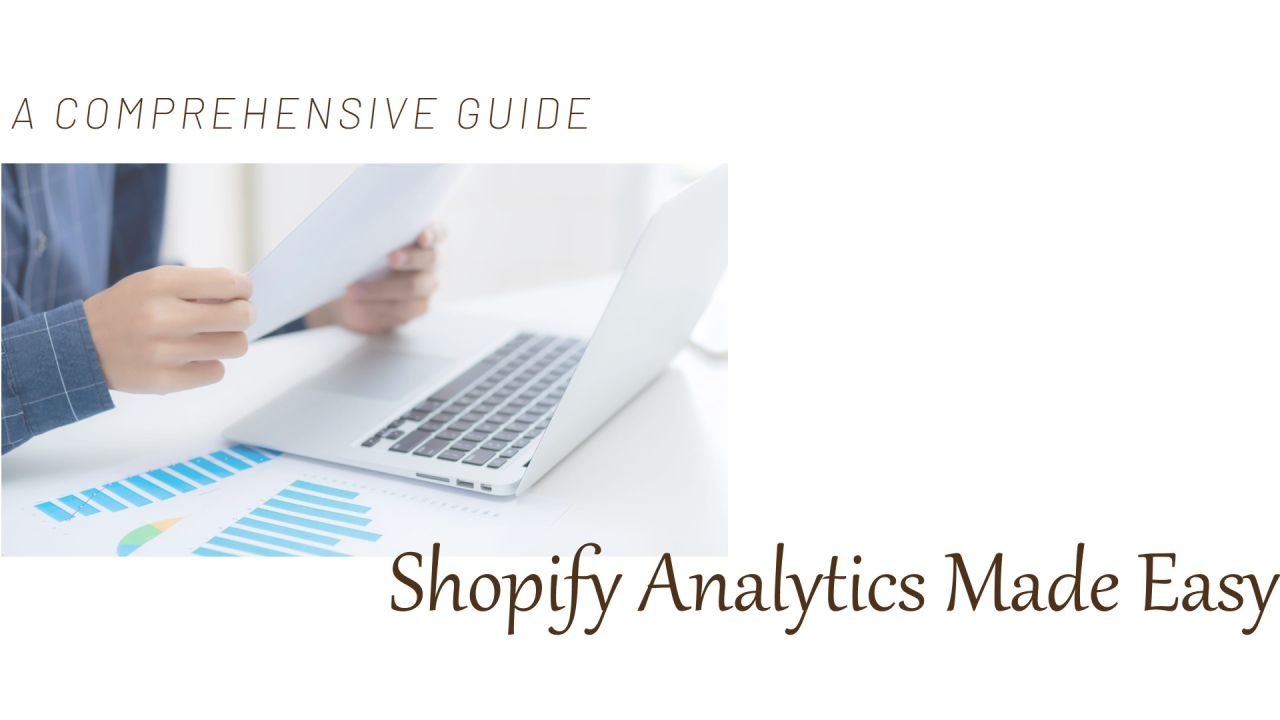In the competitive world of e-commerce, making data-driven decisions is crucial for the growth and success of your online store. Shopify Analytics offers a comprehensive suite of tools that provide valuable insights into your store’s performance, helping you understand customer behaviour, track sales, and optimize your marketing strategies. By effectively leveraging Shopify Analytics, you can make informed decisions that drive growth and improve your bottom line. Here’s how to use Shopify Analytics to grow your online store:
-
Understanding Shopify Analytics:
Shopify Analytics is a powerful feature that gives store owners access to a wide range of reports and metrics. These include overviews of total sales, average order value, conversion rates, customer acquisition, and much more. By familiarizing yourself with these metrics, you can gain a holistic view of your store’s performance and identify areas for improvement.
-
Key Metrics to Track:Total Sales:
Total sales metrics provide an overview of your store’s revenue over a specific period. Monitoring these figures helps you understand your store’s financial health and set realistic sales targets.
Average Order Value (AOV):AOV measures the average amount spent by customers per order. Increasing your AOV can significantly boost your revenue. Strategies to enhance AOV include upselling, cross-selling, and offering bundle discounts.
Conversion Rate: The conversion rate is the percentage of visitors who make a purchase. A high conversion rate indicates effective marketing and a user-friendly shopping experience. Analysing conversion rates helps you identify and address barriers to purchase.
Customer Acquisition Cost (CAC): CAC measures the cost of acquiring a new customer. By comparing CAC with the lifetime value of a customer (LTV), you can evaluate the profitability of your marketing campaigns and adjust your budget accordingly.
Customer Lifetime Value (LTV): LTV predicts the total revenue a customer will generate over their lifetime. A higher LTV suggests loyal customers and effective retention strategies. Increasing LTV can be achieved through excellent customer service, loyalty programs, and personalized marketing. -
Utilizing Sales Reports :
Sales reports in Shopify Analytics provide detailed insights into your store’s sales performance. These reports can be broken down by product, location, marketing channel, and more. By analysing sales reports, you can identify your best-selling products, understand regional preferences, and determine the effectiveness of your marketing campaigns.
Product Sales Report: This report highlights which products are performing well and which are not. Use this information to adjust your inventory, discontinue underperforming products, and focus on promoting top-sellers.
Sales by Traffic Source: Understanding where your traffic is coming from can help you allocate your marketing budget more effectively. Whether it’s organic search, social media, or paid ads, knowing your best traffic sources allows you to invest in the most profitable channels.
Sales by Location: Geographical data helps you understand where your customers are located. This information can guide your marketing efforts, shipping strategies, and even product offerings to cater to specific regional demands. -
Enhancing Marketing Strategies:
Shopify Analytics can significantly enhance your marketing strategies by providing insights into customer behaviour and preferences. Use these insights to create targeted marketing campaigns that resonate with your audience.
Email Marketing: Analyse customer data to segment your email list and send personalized emails. Tailored promotions, product recommendations, and personalized messages can improve engagement and conversion rates.
Social Media Marketing: Track which social media platforms drive the most traffic and sales. Focus your efforts on these platforms to maximize your return on investment. Use data insights to refine your social media content strategy.
Paid Advertising: Monitor the performance of your paid advertising campaigns. Identify which ads generate the highest ROI and adjust your ad spend accordingly. Use A/B testing to optimize your ad creatives and targeting. -
Improving Customer Retention:
Customer retention is crucial for sustainable growth. Shopify Analytics provides valuable insights into customer behaviour, enabling you to implement strategies to improve retention.
Customer Segmentation: Segment your customers based on their purchase behaviour, preferences, and demographics. Tailor your marketing efforts to each segment to improve customer satisfaction and loyalty.
Loyalty Programs: Implement loyalty programs to reward repeat customers. Use analytics to track the effectiveness of these programs and make adjustments to maximize customer engagement.
Personalized Recommendations: Use purchase history and browsing data to offer personalized product recommendations. This enhances the shopping experience and encourages repeat purchases. -
Optimizing Store Performance:
Analysing your store’s performance data can help you identify areas for optimization. This includes improving your website’s speed, enhancing the user experience, and streamlining the checkout process.
Website Speed: A fast-loading website improves user experience and reduces bounce rates. Use analytics to monitor your website’s performance and identify any slow-loading pages.
User Experience: Analyse user behaviour on your site to identify any friction points. Simplify navigation, improve product descriptions, and ensure a seamless checkout process to enhance user experience.
Checkout Process: A complicated checkout process can lead to cart abandonment. Use analytics to track where customers drop off and optimize the checkout flow to minimize abandonment rates. -
Leveraging Advanced Analytics Tools
In addition to Shopify’s built-in analytics, consider integrating advanced analytics tools such as Google Analytics, Hotjar, or Mixpanel. These tools offer deeper insights into user behaviour and can provide more granular data to inform your decisions.
Google Analytics: Integrate Google Analytics with your Shopify store for enhanced tracking capabilities. Gain insights into user demographics, behaviour, and conversion paths to optimize your marketing strategies.
Hotjar: Hotjar provides heatmaps, session recordings, and surveys to help you understand how users interact with your site. Use these insights to identify pain points and improve user experience.
Mixpanel: Mixpanel offers advanced analytics and tracking features to help you analyse user behaviour in detail. Use it to track user interactions, analyse conversion funnels, and measure the impact of your marketing campaigns.
In conclusion, leveraging Shopify Analytics is essential for the growth and success of your online store. By understanding and utilizing the wealth of data available, you can make informed decisions that drive sales, improve customer satisfaction, and optimize your overall business performance. Embrace a data-driven approach to e-commerce and watch your Shopify store thrive in the competitive online marketplace

